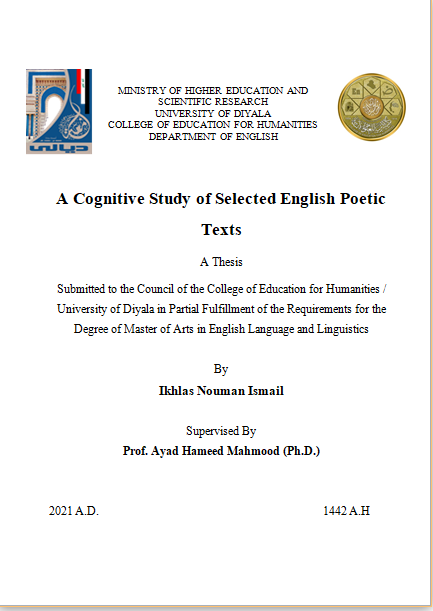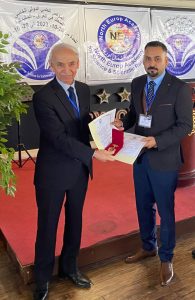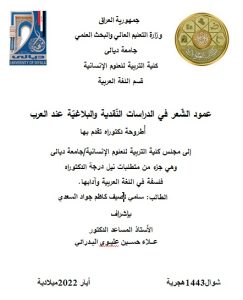ABSTRACT
This study is an attempt to investigate the possibility of applying Langacker's (2008 /2013) construal model to a sample of selected English Ekphrastic poetic texts and the canvases they are based on. The study is grounded on hypotheses which are: construal model can be applied to Ekphrastic poetic texts and the canvases they are based on, and at the same time the study tries to investigate about the similarities or differences between visual and verbal texts in terms of meaning construction, conceptual and compositional structures, and whether they submit to the same coding process. The study also tries to account for the phenomenon of multiple -construals of visual and verbal texts ,and exam whether a verbal text can extract the target sense of a visual text and convey its content by verbal entities.
The study aims at finding out ,the applicability of construal model to Ekphrastic poetic texts and the canvases they are based on ,and whether or not construal dimensions can be equally applied to poetic texts and canvases ,The study exams the efficiency of construal model to show the similarities and differences between poetic texts and canvases in terms of meaning construction. The study tries to prove that visual and verbal texts have similar conceptual and compositional structure, and submit to the same coding process. Add to that construal model can account for the phenomenon of multiple-construals of visual and verbal texts, and verbal text can extract the target sense of a visual text and convey its content by verbal entities. The study also aims at finding out the efficiency of the model to account for the reasons behind the variety of construals of these texts by conceptualisers.
To achieve the aims of the study, two types of procedures are adopted: theoretical and practical. The theoretical procedures consist of two chapters .Chapter two presents a theoretical framework of a broad overview of the nature, history, development of Cognitive Poetics (henceforth CP) , and its overlapping with poetry in general and cognition studies in particular. It also discusses the principles of CP, its basic notions including Cognitive Grammar (henceforth CG) and Lngacker’s construal model within CG. The final section discusses Ekphrastic Poetry.
Chapter three surveys visual Language ( henceforth VL), and visual cognition, it is divided into two sections: a theoretical background of VL, and visual cognition and previous studies. It includes an overview of VL, its functions, structural components of compositional and content levels, and the scientific perspective about it. The second part includes previous studies and the comparison between the present study with previous studies.
Chapter five represents the practical procedures ,it investigates the capability of applying construal dimensions and their parameters on the visual and verbal domains through canvases and their ekphrastic texts. The analysis involves inspecting how they transfer the intended message between them, and if they can reflect each other equally. And whether the construal dimensions behave the same in both fields and reflect the same characteristics. End this Chapter with the discussion of the results of analysing canvases. The adopted model has applied to the selected texts which consist (1) two visual texts: Van Gogh's (1889) The Starry Night, and Medusa's Head by a Flemish painter, CA.(1600), and (2) their Ekphrastic texts: Percy Bysshe Shelley's (1819) “On the Medusa of Leonardo da Vinci, In the Florentine Gallery” , and Anne Sexton’s (1961) “The Starry Night”.
The study have shown that except Trajector/ landmark alignment (henceforth TR/LM ) parameter, the construal dimensions of specificity, focusing, prominence, and perspective can be applied to both linguistic and visual domains analogically. The results also have shown that canvases and poems have the same conceptual base since they are part of the semiotic world which means they have the same content base and submit to the same coding process though they belong to different domains.
The study have also believed that construal phenomenon is a part of universal phenomenon of human cognitive production. Though it is designed in modern studies, it can be applied to text written in old eras such as the Romantic era. It can also be applied to different schools or domains of art. Construal dimensions are highly overlapping concepts. They can be recognised almost in each text in the manner of layers depending on the target purposes and accessibility. They can also extend to profiling symbolic assemblies with the same conceptual base. Reversing any parameter of construal dimensions vis-à-vis another leads to a change of content of the target scene.
The study have shown VL, especially painting and its structure as verbal language, consists of many layers that extend from the smallest elements, metaphorically called morphemes, into larger constructions, in our case, the final piece. VL has its unique components like syntax, semantics, and pragmatics. At the end the results of the study have revealed The multiple -construals phenomenon that associates with visual and verbal texts in the present study is due to the following factors: the nature of the subject(s)of conceptualisation, the grounding elements of the subject(s) of conceptualisation, the structure of the object of conceptualisation, the temporal dimension, the linearity and stratify nature of language ,and context.
The study ends up with a number of recommendations and suggestions for further studies that could reflect the values of study as theoretical and practical significance to scholars in the area of cognitive Grammar, semantics, and pragmatics. The study findings can also be significant in arts, literary studies, and translation.




